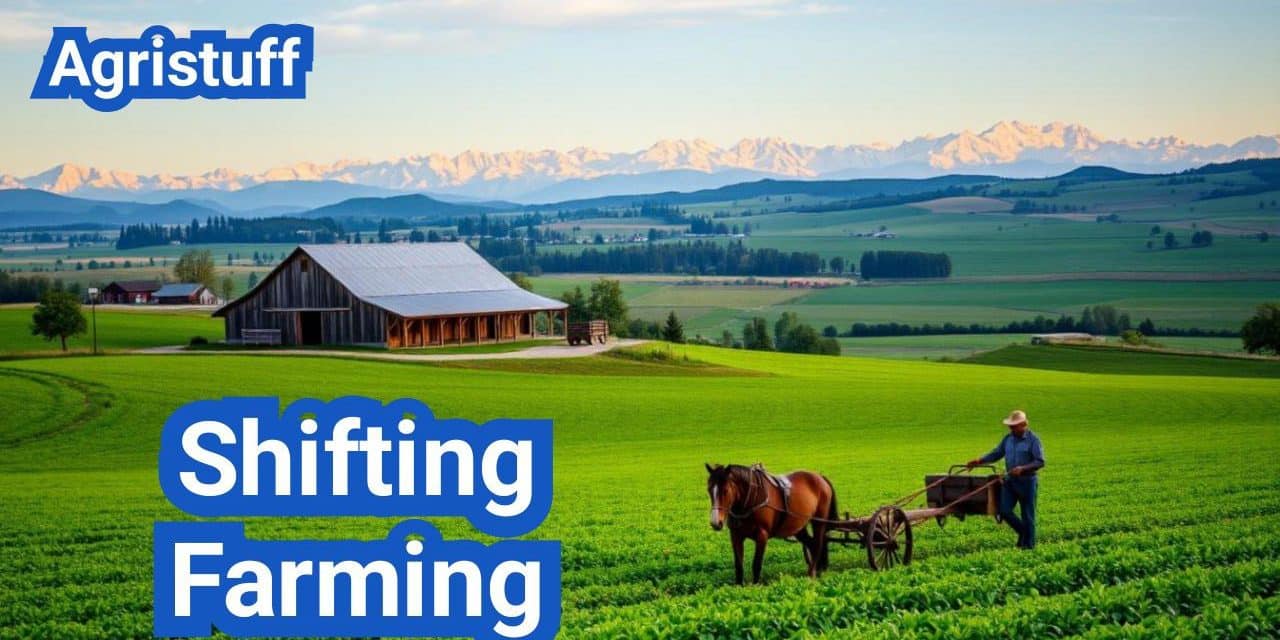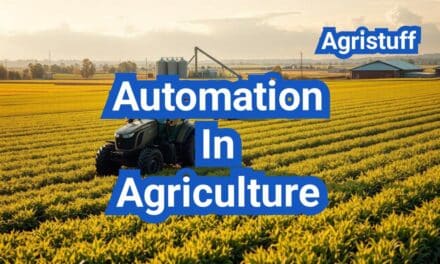Shifting farming is an agricultural practice that involves temporarily cultivating plots of land, then abandoning them to allow vegetation to regrow while moving on to another plot.
This method, also known as shifting cultivation, is significant in various parts of the world, particularly in regions where land is plentiful but labor is scarce. It is closely related to sustainable agriculture and agroforestry practices, as it promotes soil fertility and biodiversity.
Understanding shifting farming is crucial for appreciating its role in regenerative farming and climate-resilient agriculture A ta local level, it contributes to food security and ecosystem health.
Key Takeaways
- Shifting farming is a temporary cultivation method that allows land to regrow vegetation.
- It is a significant practice in various parts of the world, especially where land is abundant.
- This method is closely linked to sustainable agriculture and agroforestry.
- Shifting farming promotes soil fertility and biodiversity.
- It plays a role in regenerative and climate-resilient agriculture.
Understanding Shifting Farming: Definition and Basics
Shifting farming, a traditional agricultural practice, involves the rotation of land to maintain soil fertility and support crop growth. This method has been employed for centuries in various parts of the world, particularly in tropical and subtropical regions.
What Is Shifting Farming?
Shifting farming is defined as an agricultural system where land is cleared, cultivated for a few years, and then abandoned to allow for natural regeneration. This practice is also closely tied to the concept of agroecology, as it works with the natural ecosystem to maintain soil health and biodiversity.
The process begins with the selection of a plot of land, typically in a forested area. The vegetation is cleared, and the land is prepared for cultivation. Crops are then planted, and the land is used for a few years until the soil fertility declines. At this point, the land is left fallow, and a new plot is selected for cultivation.
Different Names: Slash-and-Burn, Swidden Cultivation
Shifting farming is known by various names across different cultures and regions. Two of the most common alternative names are slash-and-burn agriculture and swidden cultivation. These terms refer to the practice of clearing land by cutting down vegetation and thenzat burning it to prepare the soil for cultivation.
Slash-and-burn agriculture is a widely recognized term that describes the initial stages of shifting farming. Swidden cultivation, on the other hand, encompasses the entire cycle of land preparation, cultivation, and fallow periods.
Core Components of the Practice
The core components of shifting farming include land selection, clearing and burning vegetation, cultivating crops, and allowing the land to lie fallow. This practice relies heavily on traditional farming methods and a deep understanding of local ecosystems.
- Land selection based on factors like soil quality and vegetation density
- Clearing and burning vegetation to prepare the soil
- Cultivating a variety of crops, often using polyculture techniques
- Allowing the land to regenerate during the fallow period
By understanding these core components, it becomes clear how shifting farming operates as a holistic agricultural system that is deeply intertwined with the local environment.
The Historical Context of Shifting Cultivation
For centuries, shifting cultivation has been an integral part of the cultural and agricultural landscape of many indigenous societies. This traditional farming method has not only provided sustenance but has also played a crucial role in shaping the identity and practices of these communities.
Origins and Evolution
The origins of shifting cultivation are deeply rooted in history, with evidence suggesting that it has been practiced for thousands of years. “Shifting cultivation is one of the oldest forms of agriculture, with its roots tracing back to the Neolithic period,” as noted by historians studying ancient agricultural practices. Over time, this method has evolved, adapting to changing environmental conditions and societal needs.
The evolution of shifting cultivation has been influenced by various factors, including population dynamics, technological advancements, and environmental pressures. Despite these changes, the core principles of this agricultural practice have remained relatively intact, reflecting its resilience and adaptability.
Traditional Importance in Indigenous Communities
In indigenous communities, shifting cultivation is more than just a farming technique; it is a way of life. It is intricately linked with their cultural heritage, spiritual beliefs, and social organization. The practice is often communal, involving collective decision-making and labor sharing, which strengthens community bonds.
Cultural preservation is a significant aspect of shifting cultivation, as it embodies traditional knowledge and practices passed down through generations. As one indigenous leader noted, “Our farming practices are not just about growing crops; they are about preserving our culture and way of life.”
Historical Practices Across Different Regions
Shifting cultivation has been practiced across various regions, including tropical and subtropical areas. Each region has its unique variations of this agricultural method, influenced by local climate, soil conditions, and cultural traditions.
- In Southeast Asia, for example, shifting cultivation has been a dominant agricultural practice, with communities cultivating rice and other crops in rotation.
- In parts of Africa, shifting cultivation is used in conjunction with other farming practices, showcasing its adaptability to different agricultural contexts.
- In the Amazon region, indigenous communities have practiced shifting cultivation for centuries, developing sophisticated knowledge of forest ecology and management.
These regional practices highlight the diversity and flexibility of shifting cultivation, underscoring its significance as a global agricultural phenomenon.
How Shifting Farming Works: A Step-by-Step Process

Understanding how shifting farming works requires a breakdown of its step-by-step process. This agricultural practice involves a series of activities that are crucial for its success, from selecting the right site to cultivating crops.
Site Selection Criteria
The first step in shifting farming is selecting a suitable site. Farmers typically look for areas with fertile soil, adequate vegetation, and access to water. The site selection process is critical as it determines the potential yield and sustainability of the farming practice.
Key factors in site selection include:
- Soil quality and fertility
- Presence of indicator plants
- Accessibility to the site
- Proximity to water sources
Land Clearing Techniques
Once a site is selected, the next step is clearing the land. This involves removing vegetation, trees, and other obstacles to prepare the soil for cultivation. Various techniques are used, including manual clearing, mechanical clearing, and chemical clearing.
The choice of technique depends on the size of the area, the type of vegetation, and the available resources.
Controlled Burning Methods and Timing
After clearing, controlled burning is often used to manage the site further. This process involves burning the cleared \ vegetation under controlled conditions to:
- Reduce weed competition
- Improve soil fertility through ash
- Clear debris
The timing of controlled burning is crucial and typically occurs during the dry season to minimize the risk of uncontrolled forest fires.
Planting and Cultivation Practices
Following the controlled burn, the site is ready for planting. Crops are selected based on their suitability to the local climate and soil conditions. Common crops include staple foods like maize, cassava, and yams.
Cultivation practices involve:
- Monitoring crop health
- Managing pests and diseases
- Maintaining soil fertility
By understanding these steps, it’s clear that shifting farming is a multifaceted process that requires careful planning and execution.
The Cycle of Shifting Cultivation
At the heart of shifting cultivation lies a cyclical pattern of farming and land regeneration. This cycle is crucial for the sustainability of the practice, allowing farmers to maintain soil fertility and reduce the need for external inputs.
Understanding Fallow Periods
Fallow periods are a critical component of shifting cultivation. These periods allow the land to regenerate after being cultivated, replenishing soil nutrients and reducing pest and disease pressure. The length of fallow periods can vary significantly based on factors such as soil type, climate, and vegetation regrowth.
Factors Influencing Fallow Periods
- Soil health and fertility
- Vegetation regrowth rate
- Climate conditions
- Land use history
Land Regeneration Process
The land regeneration process is vital for the success of shifting cultivation. During fallow periods, natural vegetation recolonizes the area, improving soil health through the addition of organic matter and the reduction of soil erosion.
Ecological Benefits
- Soil rejuvenation
- Biodiversity conservation
- Carbon sequestration
| Ecological Benefits | Description |
|---|---|
| Soil Rejuvenation | Improvement in soil health through organic matter addition |
| Biodiversity Conservation | Protection and enhancement of local ecosystems |
| Carbon Sequestration | Reduction of atmospheric carbon through vegetation growth |
Determining When to Return to Previous Plots
Farmers use various indicators to determine when to return to previously cultivated plots. These include observing vegetation regrowth, assessing soil fertility, and evaluating the overall health of the ecosystem.
By understanding and managing the cycle of shifting cultivation effectively, farmers can maintain the productivity of their land while minimizing environmental impact.
Tools and Equipment Used in Shifting Farming

The success of shifting farming depends on the appropriate use of tools and equipment, tailored to the specific needs of the land. This agricultural practice has been around for centuries, and over time, farmers have developed and adapted various tools to make the process more efficient.
Traditional Implements
Traditional implements play a crucial role in shifting farming. These tools have been used for generations and are often simple, yet effective. Some of the most common traditional implements include:
- Machetes: Used for clearing vegetation and cutting down trees.
- Axes: Employed for chopping wood and larger trees.
- Digging sticks: Utilized for planting seeds and tubers.
- Knives: Used for various tasks, including harvesting and weeding.
These traditional tools are often made from locally sourced materials and are well-suited to the specific needs of shifting farming.
Modern Adaptations
In recent years, many shifting farmers have begun to adopt modern tools and equipment to improve efficiency and productivity. Some examples include:
- Mechanized land clearing equipment: Such as tractors and bulldozers, which can clear larger areas more quickly.
- Precision agriculture tools: Like GPS-guided planters and drones, which can help optimize crop yields.
- Improved hand tools: Made from durable materials like steel and aluminum, which can make tasks easier and faster.
These modern adaptations can help reduce the labor intensity of shifting farming and improve overall productivity.
Safety Equipment for Controlled Burns
Controlled burning is a critical component of shifting farming, but it can be hazardous if not managed properly. To mitigate these risks, farmers use various safety equipment, including:
- Fire-resistant clothing: Such as gloves, masks, and protective suits.
- Firebreaks: Created using tools like plows or by clearing vegetation to contain the fire.
- Monitoring equipment: Like weather stations and fire detectors, which help predict and manage fire behavior.
Using the right safety equipment is crucial for preventing accidents and ensuring a successful controlled burn.
In conclusion, the tools early used in shifting farming are diverse, ranging from traditional implements to modern adaptations. The choice of tool often depends on the specific needs of the farmer, the terrain, and the type of crops being grown. By understanding the various tools and equipment available, farmers can make informed decisions to improve their shifting farming practices.
Crops Commonly Grown in Shifting Cultivation Systems
In shifting cultivation, farmers typically grow a mix of staple food crops and cash crops. This diverse agricultural practice allows for a varied diet and provides opportunities for income generation through the sale of surplus produce.
Staple Food Crops
Staple food crops are the backbone of shifting cultivation systems, providing sustenance for the farming families. Common staple crops include:
- Rice
- Maize
- Millet
- Cassava
- Sweet potatoes
These crops are often chosen for their hardiness and ability to thrive in the local conditions. Maize, for example, is a popular choice due to its versatility and nutritional value.
Cash Crops
In addition to staple foods, many shifting cultivation systems incorporate cash crops to generate income. These may include:
- Coffee
- Cocoa
- Chili peppers
- Fruits like bananas or pineapples
The sale of these crops in local or international markets can significantly improve the livelihoods of farming families.
Complementary Planting Strategies
Complementary planting strategies are integral to the success of shifting cultivation. By planting multiple crops together, farmers can enhance biodiversity, improve soil health, and reduce pest and disease pressure. Some common strategies include:
- Intercropping: Planting different crops together in the same field.
- Agroforestry: Integrating trees into the farming system.
- Companion planting: Pairing crops that benefit from each other’s growth.
These agroecological practices not only improve crop yields but also contribute to the sustainability of the farming system. By adopting such strategies, farmers can maintain soil fertility, conserve water, and protect against environmental degradation.
Geographic Distribution: Where Shifting Farming Is Practiced

The geographic distribution of shifting farming encompasses a broad range of territories, including tropical and subtropical areas across the globe. This agricultural practice is not limited to specific regions but is found in various parts of the world where the climate and land use patterns are suitable.
Tropical Regions
Tropical regions are among the primary locations for shifting farming due to their favorable climate and rich biodiversity. Countries near the equator, such as those in Southeast Asia, Central Africa, and parts of South America, have vast areas where this practice is prevalent. The high temperatures and rainfall in these regions support the growth of a wide variety of crops.
As noted by a researcher, “Tropical forests are crucial for the survival of shifting cultivation, as they provide the necessary nutrients and biodiversity for the system to thrive.”
This practice is deeply intertwined with the cultural and traditional practices of indigenous communities living in these regions.
Subtropical Areas
In addition to tropical regions, subtropical areas also host shifting farming practices. These regions, characterized by mild winters and hot, humid summers, offer suitable conditions for a range of crops. Subtropical zones in countries like China, India, and Cortes in Mexico are examples where shifting cultivation is practiced.
The adaptability of shifting farming to subtropical climates highlights its flexibility and the resourcefulness of farmers who employ this method.
Case Studies from Different Continents
Case studies from various continents illustrate the diversity and adaptability of shifting farming. For instance, in Africa, the practice is integral to the livelihoods of many communities, with crops like maize and yams being staple foods. In Asia, particularly in Indonesia and Malaysia, shifting cultivation involves the planting of rice and other vegetables.
- In South America, countries like Brazil and Peru have communities that practice shifting farming, focusing on crops such as manioc and sweet potatoes.
- In North America, some indigenous communities continue the tradition of shifting cultivation, adapting it to local conditions.
These case studies demonstrate the widespread nature of shifting farming and its significance in different cultural and ecological contexts.
Environmental Impact of Shifting Farming

Shifting farming, a traditional agricultural practice, has significant environmental implications that need to be understood. As the world grapples with the challenges of sustainable agriculture, assessing the ecological footprint of such practices becomes increasingly important.
Soil Health Effects
The impact of shifting farming on soil health is a critical aspect of its environmental footprint. The practice involves clearing land, which can lead to soil erosion and nutrient depletion. However, during the fallow periods, soil can regenerate. Efficient soil management is crucial to maintaining soil health.
A study on the effects of shifting cultivation on soil properties found that after a few years of cultivation, soil fertility significantly decreases, but it can recover during the fallow period (Source not available for citation).
| Soil Property | After Cultivation | After Fallow |
|---|---|---|
| Nitrogen Content | Low | High |
| Organic Matter | Reduced | Recovered |
Impact on Biodiversity
Shifting farming affects biodiversity in various ways. The clearing of forests can lead to habitat loss for many species. However, the mosaic of different fallow ages in shifting cultivation landscapes can also contribute to biodiversity conservation.
“The mosaic of different fallow ages in shifting cultivation landscapes can contribute to biodiversity conservation by providing a variety of habitats for different species.”
Carbon Sequestration and Emissions
Shifting farming has implications for carbon sequestration and emissions. The burning of biomass releases carbon dioxide, contributing to greenhouse gas emissions. On the other hand, regrowing vegetation during fallow periods can sequester carbon.
Comparing Environmental Footprint
When comparing the environmental footprint of shifting farming with other agricultural systems, several factors come into play. Shifting farming can be more sustainable than intensive agriculture in certain contexts due to its lower use of external inputs.
- Lower chemical inputs
- Potential for biodiversity conservation
- Soil regeneration during fallow periods
However, its extensive land use can be a drawback. A comprehensive comparison with other agricultural practices is necessary to fully understand its environmental impact.
The Shifting Cultivation Juggernaut: Addressing Attribution Problems

Shifting cultivation, a traditional agricultural method, faces numerous challenges due to attribution problems and misconceptions. This ancient practice, used by many indigenous communities worldwide, is often misunderstood, leading to incorrect assumptions about its environmental and social impacts.
Common Misconceptions
One of the primary attribution problems associated with shifting cultivation is the misconception that it is a destructive practice that leads to deforestation and biodiversity loss. While it’s true that shifting cultivation involves land clearing, the impact is often exaggerated, and the nuances of the practice are overlooked.
In reality, shifting cultivation is a complex system that involves rotating crops and allowing land to fallow, which can help maintain soil fertility and biodiversity. However, when not managed properly, it can lead to environmental degradation.
- Misconception: Shifting cultivation is a primitive and unproductive farming method.
- Reality: When managed sustainably, shifting cultivation can be a highly productive and resilient agricultural system.
Scientific Perspectives
Scientific research has provided valuable insights into the impacts of shifting cultivation. Studies have shown that, when practiced sustainably, shifting cultivation can maintain ecosystem services and support biodiversity.
“Shifting cultivation, when managed properly, can be a sustainable and environmentally friendly agricultural practice.”
— A study on sustainable agriculture practices
However, scientific perspectives also highlight the challenges associated with shifting cultivation, including the need for careful land management and the potential for environmental degradation if not practiced sustainably.
Balancing Traditional Knowledge with Modern Science
To address the attribution problems surrounding shifting cultivation, it’s essential to balance traditional knowledge with modern science. Indigenous communities have practiced shifting cultivation for centuries, developing a deep understanding of the land and its management.
By combining traditional knowledge with scientific research, we can gain a more comprehensive understanding of the impacts of shifting cultivation and identify strategies for sustainable practice.
Key strategies for balancing traditional knowledge with modern science include:
- Collaborating with indigenous communities to understand their traditional practices and knowledge.
- Applying scientific research to identify best practices and potential challenges.
- Developing policies and programs that support sustainable shifting cultivation practices.
Advantages of Shifting Farming Systems

Shifting farming provides a range of benefits, from ecological advantages to economic and cultural preservation. This farming method has been practiced for centuries, offering numerous benefits that contribute to its sustainability and appeal.
Ecological Benefits
Shifting cultivation promotes ecological balance through several mechanisms. It allows for forest regeneration during fallow periods, which enhances biodiversity and maintains ecosystem services. The practice also contributes to soil conservation by reducing erosion through root systems and soil cover.
- Promotes biodiversity through varied land use
- Enhances ecosystem services like pollination and pest control
- Supports forest regeneration during fallow periods
Economic Advantages for Small-Scale Farmers
Shifting farming offers economic benefits to small-scale farmers, primarily through low initial investment and the ability to cultivate a variety of crops. This method allows farmers to diversify their income sources and improve their resilience to market fluctuations.
- Reduces the need for external inputs like fertilizers and pesticides
- Provides a diverse range of crops for varied income streams
- Enhances food security through staple crop production
Cultural Preservation
Shifting cultivation is deeply intertwined with the cultural practices and traditional knowledge of indigenous communities. It plays a crucial role in cultural preservation by maintaining traditional farming practices and rituals associated with land use.
- Maintains traditional knowledge and farming practices
- Supports cultural rituals and community activities
- Preserves indigenous identities tied to land use
Low External Input Requirements
One of the significant advantages of shifting farming is its low dependency on external inputs such as synthetic fertilizers and pesticides. This reduces the financial burden on farmers and minimizes the environmental impact of agricultural activities.
The practice relies on natural processes like nutrient cycling and biological pest control, making it a sustainable option for many communities.
Is Shifting Cultivation Subsistence or Commercial?

Shifting cultivation operates on a spectrum between subsistence and commercial farming, depending on the context. This agricultural practice has been a cornerstone for many communities worldwide, serving various economic and nutritional needs.
Traditional Subsistence Practices
Traditionally, shifting cultivation has been associated with subsistence farming, where families or communities grow crops primarily for their own consumption. This practice is deeply rooted in indigenous cultures and is often characterized by a diverse range of crops grown together, enhancing food security and sovereignty.
- Crops are selected based on local preferences and nutritional needs.
- Farmers often use traditional knowledge passed down through generations.
- The practice supports community cohesion through shared labor and knowledge.
Commercial Adaptations
In recent years, there has been a shift towards commercial adaptations of shifting cultivation. This involves producing crops not just for local consumption but also for sale in local or international markets. Commercialization can provide farmers with a source of income, potentially improving their livelihoods.
- Cash crops are introduced or emphasized, such as coffee or cocoa.
- Farmers may adopt more modern farming techniques to increase yield.
- Market demands and prices can significantly influence farming decisions.
Hybrid Models in Modern Contexts
The emergence of hybrid models represents a significant evolution in shifting cultivation. These models blend elements of both subsistence and commercial farming, allowing communities to benefit from the advantages of both approaches. Hybrid models can enhance resilience and adaptability in the face of economic and environmental changes.
| Model | Characteristics | Benefits |
|---|---|---|
| Subsistence | Primarily for local consumption, diverse crops | Food security, cultural preservation |
| Commercial | Focus on cash crops, market-oriented | Income generation, economic growth |
| Hybrid | Combines subsistence and commercial elements | Resilience, adaptability, diversified income |
In conclusion, shifting cultivation cannot be strictly categorized as either subsistence or commercial; it encompasses a range of practices that can vary significantly across different contexts. Understanding these nuances is crucial for supporting farmers and communities that rely on this agricultural method.
Challenges and Limitations of Shifting Cultivation

The sustainability of shifting cultivation is threatened by several key factors. As a traditional farming practice, it faces numerous pressures that impact its long-term viability.
Population Pressure
One of the significant challenges is population pressure. As populations grow, the land available for shifting cultivation is reduced, leading to shorter fallow periods and decreased soil fertility.
- Increased population density results in higher demand for food, putting pressure on the land.
- Shorter fallow periods reduce the land’s ability to regenerate.
- This can lead to soil degradation and decreased crop yields.
Land Availability Constraints
Land availability is another critical constraint. As agricultural land is converted for other uses, such as urban development or conservation, the area available for shifting cultivation diminishes.
- Conversion of forest land for agriculture or urban use reduces available land.
- Protected areas limit access to land that was previously used for shifting cultivation.
- Land fragmentation due to inheritance or sale can further reduce viable areas.
Policy and Legal Barriers
Policy and legal frameworks often pose significant barriers to the continuation of shifting cultivation. Many governments view shifting cultivation as a primitive or destructive practice and have implemented policies to discourage or ban it.
“Policies aimed at reducing deforestation and promoting sedentary agriculture can inadvertently marginalize communities that rely on shifting cultivation.”
— Expert on indigenous agricultural practices
Climate Change Implications
Climate change is also having a profound impact on shifting cultivation. Changes in temperature and precipitation patterns can disrupt the delicate timing of agricultural cycles.
- Unpredictable weather patterns make it difficult to plan planting and harvesting.
- Increased frequency of extreme weather events can destroy crops.
- Shifts in temperature and precipitation can alter the distribution of pests and diseases.
In conclusion, shifting cultivation faces a multitude of challenges that threaten its sustainability. Addressing these challenges will require a nuanced understanding of the complex interplay betweenruple pressure, land availability, policy frameworks, and climate change.
How to Implement Sustainable Shifting Farming

Effective implementation of sustainable shifting farming involves a thorough assessment of land suitability, careful planning of rotation cycles, and strategies to minimize environmental impact.
Assessing Land Suitability
Assessing land suitability is the first step towards sustainable shifting farming. This involves evaluating the land’s potential for agriculture based on factors such as soil quality, topography, and climate.
- Soil testing to determine nutrient levels and pH
- Topographic analysis to identify areas prone to erosion
- Climate assessment to ensure compatibility with crops
Planning Effective Rotation Cycles
Planning effective rotation cycles is crucial for maintaining soil fertility and reducing pests and diseases. This involves:
- Identifying crops that are suitable for rotation
- Creating a rotation schedule that allows for adequate fallow periods
- Monitoring soil health and adjusting the rotation plan as needed
Minimizing Environmental Impact
Minimizing environmental impact is critical for sustainable shifting farming. Strategies include:
- Using controlled burning techniques to reduce emissions
- Implementing conservation tillage to minimize soil disturbance
- Protecting biodiversity by maintaining ecological corridors
Monitoring and Evaluation Methods
Regular monitoring and evaluation are essential to ensure the long-term sustainability of shifting farming practices. This includes:
- Tracking soil health indicators
- Monitoring crop yields and biodiversity
- Assessing the impact of climate change and adapting practices accordingly
By following these guidelines, farmers can implement sustainable shifting farming practices that are environmentally friendly, economically viable, and socially responsible.
Integrating Shifting Farming with Agroforestry
Integrating shifting farming with agroforestry represents a significant step towards sustainable agricultural practices. This integration combines the benefits of both systems, enhancing ecological services and improving farmer livelihoods.
Complementary Tree Species
Selecting the right tree species is crucial for successful agroforestry integration. Complementary tree species that provide shade, improve soil health, or offer additional income streams can enhance the overall productivity of the farm.
- Nitrogen-fixing trees like Gliricidia sepium can improve soil fertility.
- Timber trees such as Swietenia macrophylla can provide long-term income.
- Fruit trees like Mangifera indica can diversify farm produce and enhance food security.
Establishing Multi-Story Systems
Multi-story systems mimic natural ecosystems by layering different crops and trees. This approach can increase biodiversity, reduce soil erosion, and promote more efficient water use.
Long-Term Management Strategies
Effective long-term management is essential for the sustainability of integrated shifting farming and agroforestry systems. This includes regular monitoring of soil health, tree growth, and crop yields.
- Regular pruning and thinning of trees to maintain optimal canopy cover.
- Soil conservation measures to prevent erosion.
- Adaptive management practices based on changing climate conditions.
Economic Benefits of Integration
The integration of shifting farming with agroforestry can yield significant economic benefits. Diversified produce, including timber, fruits, and nuts, can provide additional income streams for farmers.
Moreover, improved soil health and biodiversity can lead to more resilient farming systems, reducing the risks associated with crop failures and market fluctuations.
The Future of Shifting Farming in a Changing World
As the world grapples with the challenges of climate change, the future of shifting farming hangs in the balance. This traditional agricultural practice, once widespread across tropical and subtropical regions, faces significant sustainability challenges. However, by embracing agroecology and regenerative agriculture, shifting farming can not only survive but thrive in a changing world.
The key to the future of shifting farming lies in its ability to adapt to climate change while maintaining its core principles of sustainability. By incorporating practices that enhance soil health, biodiversity, and ecosystem services, shifting farming can reduce its environmental footprint. Moreover, is not needed, so the sentence is restructured: Shifting farming can reduce its environmental footprint by adopting practices that enhance soil health, biodiversity, and ecosystem services.
Regenerative agriculture offers a promising pathway forward, focusing on soil regeneration, efficient water use, and minimal external inputs. As the global community seeks more sustainable agricultural practices, the principles of shifting farming, combined with modern agroecological insights, can contribute to a more resilient food system.
FAQ
What is shifting farming?
Shifting farming, also known as shifting cultivation, is an agricultural practice where land is cleared, cultivated for a few years, and then abandoned to allow for natural regeneration.
What are the different names for shifting cultivation?
Shifting cultivation is also known as slash-and-burn agriculture, swidden cultivation, and rotational farming.
Where is shifting cultivation practiced?
Shifting cultivation is practiced in tropical and subtropical regions around the world, including parts of Africa, Asia, and Latin America.
What are the benefits of shifting cultivation?
Shifting cultivation provides ecological benefits, economic advantages for small-scale farmers, and plays a role in cultural preservation.
What are the challenges facing shifting cultivation?
Shifting cultivation faces challenges such as population pressure, land availability constraints, policy and legal barriers, and climate change implications.
How can shifting cultivation be made more sustainable?
Shifting cultivation can be made more sustainable by assessing land suitability, planning effective rotation cycles, minimizing environmental impact, and employing monitoring and evaluation methods.
What is the role of fallow periods in shifting cultivation?
Fallow periods allow for land regeneration, soil rejuvenation, and the replenishment of vegetation, making it possible to return to previously cultivated plots.
How do farmers determine when to return to previously cultivated plots?
Farmers determine when to return to previously cultivated plots based on the regeneration of vegetation, soil health, and other environmental indicators.
What crops are commonly grown in shifting cultivation systems?
Staple food crops, cash crops, and complementary crops are grown in shifting cultivation systems to enhance biodiversity and productivity.
Can shifting cultivation be integrated with agroforestry?
Yes, shifting cultivation can be integrated with agroforestry by selecting complementary tree species, establishing multi-story systems, and developing long-term management strategies.
Is shifting cultivation subsistence or commercial?
Shifting cultivation can be both subsistence and commercial, with traditional subsistence practices coexisting with commercial adaptations and hybrid models.
What is the environmental impact of shifting cultivation?
Shifting cultivation has both positive and negative environmental impacts, including effects on soil health, biodiversity, and carbon sequestration.
How does shifting cultivation contribute to global food security?
Shifting cultivation contributes to global food security by providing food for local communities and supporting the livelihoods of small-scale farmers.
Conclusion of: Shifting Farming
Shifting farming, also known as slash-and-burn agriculture, is one of the oldest agricultural techniques practiced worldwide. Particularly common in tropical regions, this method involves the temporary cultivation of plots cleared by burning vegetation. Shifting farming provides a sustainable living for many indigenous communities but poses environmental challenges that have brought scrutiny and discussion.
Understanding Shifting Farming
Shifting farming is characterized by its cyclical nature. Farmers clear land by slashing vegetation and burning the debris. The ashes enrich the soil temporarily, allowing for crops to thrive. After a few seasons, the soil’s fertility decreases, prompting farmers to move to a new area, leaving the previous land to regenerate naturally.
This traditional technique is particularly prevalent in areas of Africa, Asia, and Latin America, providing sustenance to communities for generations.
Advantages of Shifting Farming
Shifting farming holds several benefits, especially for remote rural communities. Firstly, it requires minimal external inputs, reducing reliance on chemical fertilizers and machinery, thereby minimizing farming costs. Secondly, it supports biodiversity as fields left fallow regenerate naturally, maintaining ecological balance. Furthermore, shifting farming sustains cultural traditions, promoting indigenous knowledge and skills passed down through generations.
Environmental Impact of Shifting Farming
Despite its benefits, shifting farming can significantly impact the environment negatively. Deforestation and habitat loss are primary concerns associated with this practice. When conducted irresponsibly, it can lead to soil erosion, loss of biodiversity, and contribute to global climate change by releasing carbon stored in forests. Moreover, as population pressures increase, shorter fallow periods may prevent adequate regeneration, exacerbating environmental degradation.
Read detailed environmental impacts.
Sustainability and Shifting Farming
Sustainable shifting farming practices include longer fallow periods, crop rotation, and agroforestry. Integrating such sustainable methods can enhance soil fertility, reduce ecological damage, and support community livelihoods sustainably. Education and awareness among farmers about sustainable practices are crucial to balance productivity and environmental health.
Further sustainability insights.
Role of Shifting Farming in Indigenous Cultures
Shifting farming is deeply embedded in the cultural identity and traditional knowledge of indigenous communities. It reflects profound ecological understanding developed over centuries, fostering communal cooperation and cultural continuity. Protecting shifting farming practices means preserving indigenous heritage and respecting their rights to land and resources.
Modern Challenges to Shifting Farming
The traditional practice of shifting farming faces numerous modern challenges. Rising populations, decreasing land availability, and government regulations restricting land use significantly impact its viability. Additionally, misconceptions labeling shifting farmers as environmentally destructive further complicate the survival of this practice. Addressing these issues requires integrated policies that recognize both ecological benefits and economic necessities.
Global Perspectives and Policies
Globally, shifting farming has sparked extensive policy debates. Organizations and governments recognize the necessity of sustainable land-use practices. There is a growing trend towards implementing policies that balance ecological preservation with the livelihoods of farming communities. International cooperation and policy dialogue remain essential to the future of shifting farming.
Innovations and Improvements
Modern innovations, such as integrating shifting farming with agroforestry and permaculture techniques, offer promising pathways to improve sustainability. Technological advancements in soil conservation, better crop selection, and enhanced farming practices can significantly reduce negative environmental impacts while preserving this age-old agricultural method.
Case Studies of Successful Shifting Farming
Several communities successfully practice sustainable shifting farming. The Karen community in Thailand is a notable example, maintaining rich biodiversity and high productivity through traditional methods enhanced with modern conservation techniques. These success stories highlight the potential for sustainable shifting farming practices globally.
Future of Shifting Farming
The future of shifting farming lies in sustainability. Promoting education, awareness, and integration with modern farming techniques can transform shifting farming into a viable, ecologically beneficial agricultural practice. Policies that support indigenous rights and ecological sustainability are crucial for the continued relevance and effectiveness of shifting farming.
Final thought
Shifting farming is an ancient agricultural practice with profound cultural and ecological importance. While facing modern environmental and socio-economic challenges, sustainable management and innovative practices can ensure its viability and ecological benefits. Supporting indigenous knowledge and sustainable methods remains critical for the future of shifting farming.










